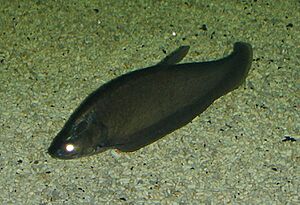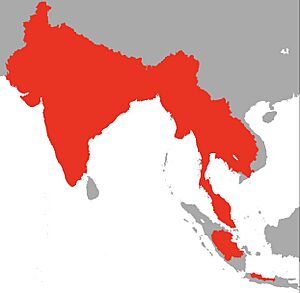Bronze featherback facts for kids
Quick facts for kids Bronze featherback |
|
|---|---|
 |
|
| Conservation status | |
| Scientific classification | |
 |
|
| Red:extant , Green: introduced | |
| Synonyms | |
|
The bronze featherback (Notopterus notopterus) is a fascinating type of ray-finned fish. This means it has fins supported by bony rays. It belongs to the Notopteridae family. You can find this fish in rivers and lakes across South Asia and Southeast Asia.
While it mostly lives in fresh water, the bronze featherback can sometimes be found in brackish water. Brackish water is a mix of fresh and salt water, like in estuaries. Currently, it's the only known member of its group, called Notopterus. However, scientists think it might actually be a "species complex." This means there could be several very similar species that look alike but are actually different.
Contents
What Does the Bronze Featherback Look Like?
Young bronze featherbacks have a dark, shiny bronze color. As they get older, their color becomes a bit lighter. These fish can grow quite large, reaching up to 60 centimeters (about 24 inches) in length.
People sometimes keep the bronze featherback in aquariums because of its unique look. This fish is also very popular as a food source in many countries. It even appeared on a postage stamp from the Kingdom of Laos!
The Bronze Featherback as Food
The bronze featherback has been an important food source in Southeast Asia for a very long time. It's still a key part of meals in countries like Indonesia, Laos, Myanmar (Burma), and Thailand. People prepare and preserve this fish in many different ways.
In Burmese cuisine, the meat of the bronze featherback is called ngaphe. It's used to make a special pressed fish pickle called ngachin. It's also used to create fish paste, which is a common ingredient in many dishes.
In Thai cuisine, there's a popular dish called nam phrik pla salat pon. This is a type of nam phrik, which is a spicy chili dip. It's made with minced (finely chopped) roasted bronze featherback. People often eat it with fresh vegetables. This dish is especially popular in the Khorat region of Thailand. Even though it's smaller, the bronze featherback looks a bit like the Chitala ornata, another important fish in Thai cooking.
See also
Images for kids




